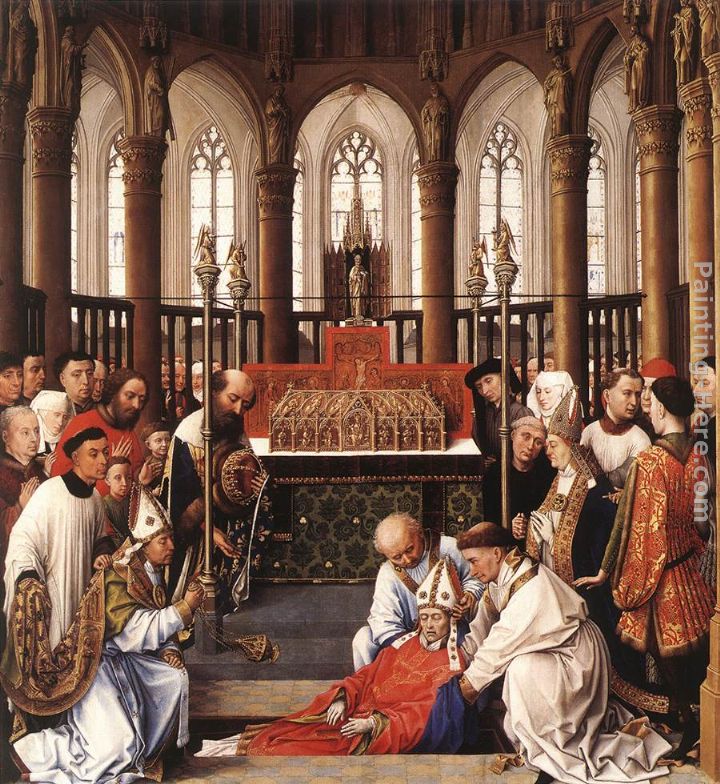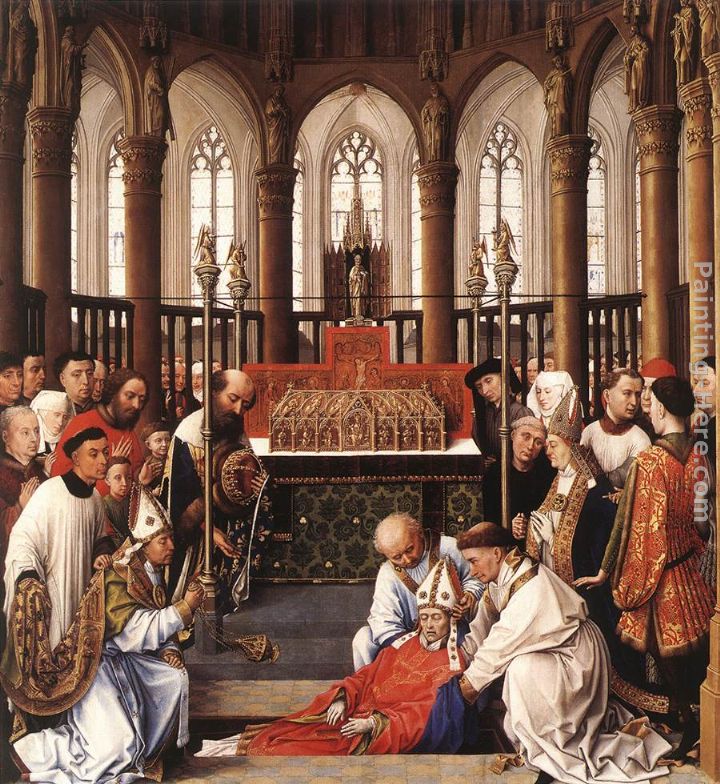 I would like to draw readers' attention to a piece in The Catholic Herald written by Fr Anthony Symondson. He has reviewed the exhibition Devotion by Design which is at the National Gallery in London and which runs until October 2nd. The exhibition is unusual in that, commendably, altarpieces are displayed along with simulated altars so that visitors can get a feel for the setting in which they ought be placed. One of the pieces on display is Rogier van der Weyden's Exhumation of St Hubert, shown left.
While the only way to get a full sense of the importance of context for such a piece is to see it in church while praying the liturgy, what the museum has done does at least indicate the intended purpose of the piece. It also makes the point that context of a painting is important and open our imaginations to what it might have been like originally. I am pleased to see a gallery thinking about this.
I would like to draw readers' attention to a piece in The Catholic Herald written by Fr Anthony Symondson. He has reviewed the exhibition Devotion by Design which is at the National Gallery in London and which runs until October 2nd. The exhibition is unusual in that, commendably, altarpieces are displayed along with simulated altars so that visitors can get a feel for the setting in which they ought be placed. One of the pieces on display is Rogier van der Weyden's Exhumation of St Hubert, shown left.
While the only way to get a full sense of the importance of context for such a piece is to see it in church while praying the liturgy, what the museum has done does at least indicate the intended purpose of the piece. It also makes the point that context of a painting is important and open our imaginations to what it might have been like originally. I am pleased to see a gallery thinking about this.
Good sacred art is painted so that it engages the person at precise moments in the liturgy and then directs their attention beyond the work of art to something greater – by for example making sure in the case of the reredos that there is sufficient contrast so that the host is visible when held aloft. This is something that artist should always be aware of. Even within a painting, one part in isolation looks different when viewed in relation to all the other parts. Artists are taught to consider the unified view. Once the form of a painting has been established – the basic shapes, tones and colours – then the so much of the final part of the process is subtle alteration using colour washes, glazes and scumbles so that each part speaks to the others in such way that the piece has unity.
 Similarly, the artist must try to consider the wider context into which it is to be placed. Works look different when placed on dark or light backgrounds, or when there are other paintings around. Also and most importantly, the position relative to the liturgy must be considered.
Similarly, the artist must try to consider the wider context into which it is to be placed. Works look different when placed on dark or light backgrounds, or when there are other paintings around. Also and most importantly, the position relative to the liturgy must be considered.
Consider Caravaggio’s Calling of St Matthew. This is a great painting even when viewed in isolation, but the ideal position for this, I suggest, is in a side chapel on the left hand ie north side of the church, on an east wall so that at the point of elevation someone in the main body of the church could see both the painting, in the left hand side of their vision, and the elevated host. This would give the appearance that the source of light was the Blessed Sacrament itself - the Light calling St Matthew - thus reinforcing visually the fact that Christ is really present within it.
One of the wonders of nature for me is how each object can be beautiful and complete in itself, can also be a beautiful part of a wider landscape and, furthermore, contains within it beautiful parts in perfect relation to each other. We need only think of a rose: each petal within it is beautiful and placed so that together they form the flower; and then each bloom is placed in relation to the others, to the stems and leaves so that we have a beautiful rosebush.
When I take commissions I do my best to have this model in mind and consider carefully not just what the form of the painting itself, also where it will be placed and how it can be most beautiful in its final setting.



